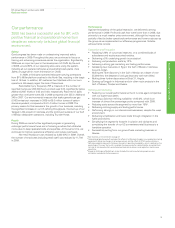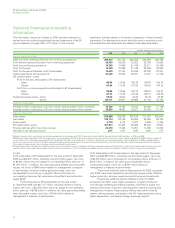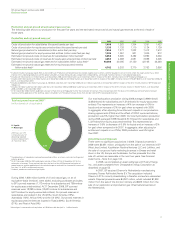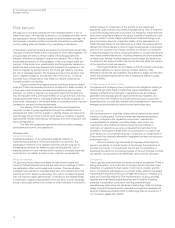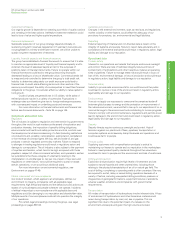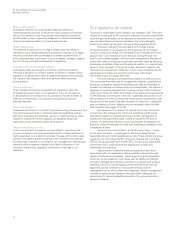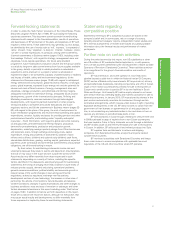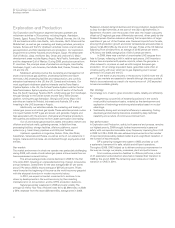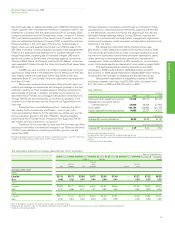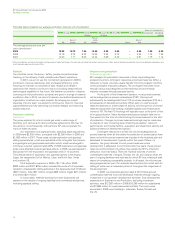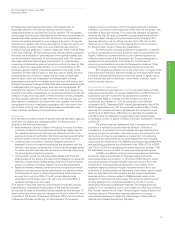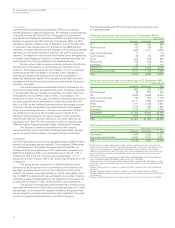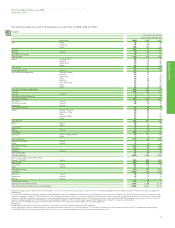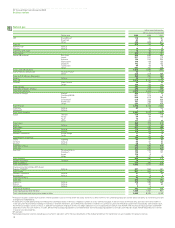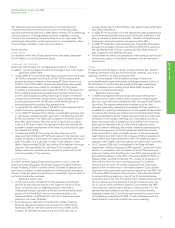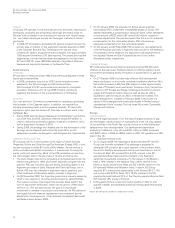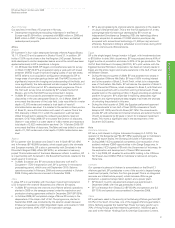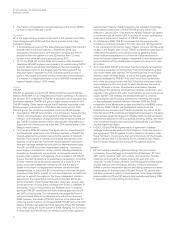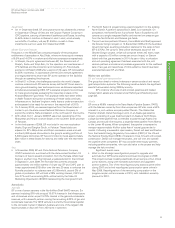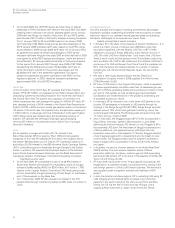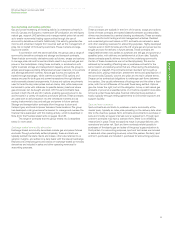BP 2009 Annual Report Download - page 27
Download and view the complete annual report
Please find page 27 of the 2009 BP annual report below. You can navigate through the pages in the report by either clicking on the pages listed below, or by using the keyword search tool below to find specific information within the annual report.
BP bases its proved reserves estimates on the requirement of
reasonable certainty with rigorous technical and commercial
assessments based on conventional industry practice. BP only applies
technologies that have been field tested and have been demonstrated to
provide reasonably certain results with consistency and repeatability in
the formation being evaluated or in an analogous formation. BP applies
high resolution seismic data for the identification of reservoir extent and
fluid contacts only where there is an overwhelming track record of
success in its local application. In certain deepwater fields, such as fields
in the Gulf of Mexico, BP has booked proved reserves before production
flow tests are conducted, in part because of the significant safety, cost
and environmental implications of conducting these tests. The industry
has made substantial technological improvements in understanding,
measuring and delineating reservoir properties without the need for flow
tests. To determine reasonable certainty of commercial recovery, BP
employs a general method of reserves assessment that relies on the
integration of three types of data: (1) well data used to assess the local
characteristics and conditions of reservoirs and fluids; (2) field scale
seismic data to allow the interpolation and extrapolation of these
characteristics outside the immediate area of the local well control; and
(3) data from relevant analogous fields. Well data includes appraisal wells
or sidetrack holes, full logging suites, core data and fluid samples. BP
considers the integration of this data in certain cases to be superior to a
flow test in providing understanding of overall reservoir performance. The
collection of data from logs, cores, wireline formation testers, pressures
and fluid samples calibrated to each other and to the seismic data can
allow reservoir properties to be determined over a greater volume than
the localized volume of investigation associated with a short-term flow
test. There is a strong track record of proved reserves recorded using
these methods, validated by actual production levels.
Governance
BP’s centrally controlled process for proved reserves estimation approval
forms part of a holistic and integrated system of internal control. It
consists of the following elements:
• Accountabilities of certain officers of the group to ensure that there
is review and approval of proved reserves bookings independent of
the operating business and that there are effective controls in the
approval process and verification that the proved reserves estimates
and the related financial impacts are reported in a timely manner.
• Capital allocation processes, whereby delegated authority is
exercised to commit to capital projects that are consistent with the
delivery of the group’s business plan. A formal review process exists
to ensure that both technical and commercial criteria are met prior to
the commitment of capital to projects.
• Internal Audit, whose role includes systematically examining the
effectiveness of the group’s financial controls designed to assure the
reliability of reporting and safeguarding of assets and examining the
group’s compliance with laws, regulations and internal standards.
• Approval hierarchy, whereby proved reserves changes above certain
threshold volumes require central authorization and periodic reviews.
The frequency of review is determined according to field size and
ensures that more than 80% of the BP proved reserves base
undergoes central review every two years and more than 90% is
reviewed centrally every four years.
BP’s segment resources authority is the petroleum engineer primarily
responsible for overseeing the preparation of the reserves estimate.
He has over 35 years of diversified industry experience with the past 10
spent as the head of the reservoir management function within BP. He is
a member of the Society of Petroleum Engineers (SPE) and the Institute
of Materials, Minerals and Mining. On the retirement of the current
segment resources authority in 2010, his responsibilities for reserves
estimation, governance and compliance will be taken by the current vice
president of segment reserves. The current vice president of segment
reserves has over 25 years of diversified industry experience with the
past seven spent managing the governance and compliance of BP’s
reserves estimation. He is a sitting member of the SPE Oil and Gas
Reserves Committee and the United Nations Economic Commission
for Europe Expert Group on Resource Classification.
For the executive directors and senior management, no specific
portion of compensation bonuses is directly related to proved reserves
targets. Additions to proved reserves is one of several indicators by
which the performance of the Exploration and Production segment is
assessed by the remuneration committee for the purposes of
determining compensation bonuses for the executive directors. Other
indicators include a number of financial and operational measures.
BP’s variable pay programme for the other senior managers in the
Exploration and Production segment is based on individual performance
contracts. Individual performance contracts are based on agreed items
from the business performance plan, one of which, if chosen, could
relate to proved reserves.
Proved reserves replacement
Total hydrocarbon proved reserves, on an oil equivalent basis including
equity-accounted entities, comprised 18,292mmboe (12,621mmboe for
subsidiaries and 5,671mmboe for equity-accounted entities) at
31 December 2009, an increase of 0.8% (increase of 0.5% for
subsidiaries and increase of 1.5% for equity-accounted entities)
compared with 31 December 2008. Natural gas represents about 43%
(55% for subsidiaries and 14% for equity-accounted entities) of these
reserves. The increase includes a net decrease from acquisitions and
divestments of 282mmboe, (59mmboe net decrease for subsidiaries
and 223mmboe net decrease for equity-accounted entities) largely
comprising a number of assets in Bolivia, Indonesia, Kazakhstan, Pakistan
and the UK.
The proved reserves replacement ratio is the extent to which
production is replaced by proved reserves additions. This ratio is
expressed in oil equivalent terms and includes changes resulting from
revisions to previous estimates, improved recovery and extensions and
discoveries, and may be expressed as a replacement ratio excluding
acquisitions and divestments or as a total replacement ratio including
acquisitions and divestments. For 2009 the proved reserves replacement
ratio excluding acquisitions and divestments was 129% (121% in 2008
and 112% in 2007) for subsidiaries and equity-accounted entities, 112%
for subsidiaries alone and 164% for equity-accounted entities alone.
In 2009, net additions to the group’s proved reserves (excluding
production, sales and purchases of reserves-in-place and equity-
accounted entities) amounted to 1,113mmboe (795mmboe for equity-
accounted entities), principally through improved recovery from, and
extensions to, existing fields and discoveries of new fields. Of our
subsidiary reserves additions through improved recovery from, and
extensions to, existing fields and discoveries of new fields, approximately
55% are associated with new projects and are proved undeveloped
reserves additions. Volumes added in 2009 principally relied on the
application of conventional technologies. The remaining additions are in
existing developments where they represent a mixture of proved
developed and proved undeveloped reserves. The principal reserves
additions in our subsidiaries were in the US (Arkoma, Mad Dog, Prudhoe
Bay, Thunder Horse), the UK (Clair), Trinidad (Kapok), Angola (Pazflor) and
Australia (Jansz-Io). The principal reserves additions in our equity-
accounted entities were in Argentina (Cerro Dragon, Cuenca Marina
Austral) and in Russia (Kamennoye, Samatlor).
25
BP Annual Report and Accounts 2009
Business review
Business review
Business review


